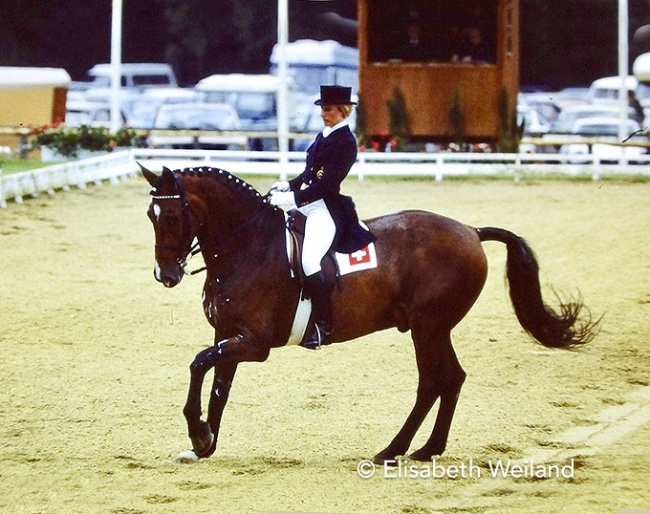
When Jennie Loriston-Clarke appeared in British daily newspapers in preview of the 4th dressage World championships, the pressure was on. In a discipline which was hardly known, even among common horse people on the island, the sister of Olympic eventing champion Jane Bullen (Holderness-Roddam) was the sole hope of the British home team to achieve a respectable placing at the 1978 World Championships in Goodwood.
That she and her stallion Dutch Courage became the shooting stars of an event still sets hearts aflutter of those who attended 44 years ago. She was the surprise of Goodwood.
To organize the World championships in dressage in Great Britain of the 1970s was a courageous decision with a certain foresightedness. Although the general situation of this discipline had improved compared to the one in the 1950s and 1960s, it was still a far cry from today in all regards.
In 1973, just five years before, the first dressage event had been held on the fabulous 4900 hectares country estate of The Duke and Duchess of Richmond and Gordon in West Sussex. From 1974 onwards Goodwood got CDI status and soon gained recognition for its wonderful facilities and unique atmosphere.
"Dressage in the Park" was the motto which was taken to the heart by riders and spectators alike who in typical British fashion enjoyed their pick-nick while riders contested for the medals.
Tumultuous Trip from Aachen to Goodwood
Just one week prior to the World championships the CHIO Aachen took place and many of the Goodwood participants used the legendary show as very last preparation in competitive conditions. Except for the teams of Great Britain, Switzerland and the Soviet Union all the others, who would meet in England a few days later, rode against each other. While the German team won the Aachen nations cup as expected, Denmark surprised with a 2nd place ahead of the USA. For Germany Aachen brought the decision to include Gabriela Grillo and her 15-year-old Trakehner gelding Ultimo (by Heros) in the team which left Uwe Sauer and his Trakehner gelding Hirtentraum (by Traumgeist xx) to be the individual rider. Back then the teams could also send an additional individual rider for the World championships of which some nations made use.
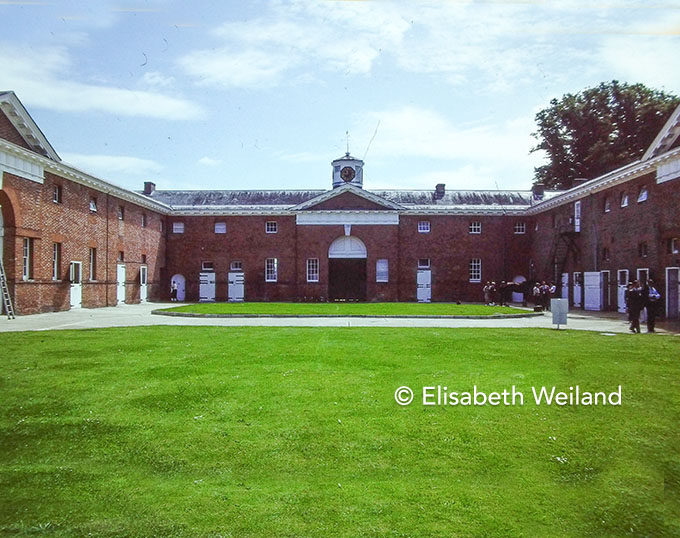
The French horses had an even more difficult journey, which team member Christian Carde told Eurodressage. Their driver forgot the health certificate of the horses at a previous border which meant the horses were immediately put into quarantine after their arrival in Dover. Only after 20 hours they were released to travel on the few extra hours to Goodwood where they also were put into quarantine stables first. As a result some horses became sick, others were simply stiff.
Luckily the Goodwood facilities were brilliant for horses, grooms, and riders alike. No stuffy small boxes in tents, but cool spacious stables in the stable wing of the country estate. Ideal conditions to recover from the travels. And the expanse of the Goodwood estates with its nearby race-track, well cared for training arenas, and beautiful lawns did the rest to help refreshen tired bodies and minds before the big days arrived.
The Medal Contenders in Goodwood
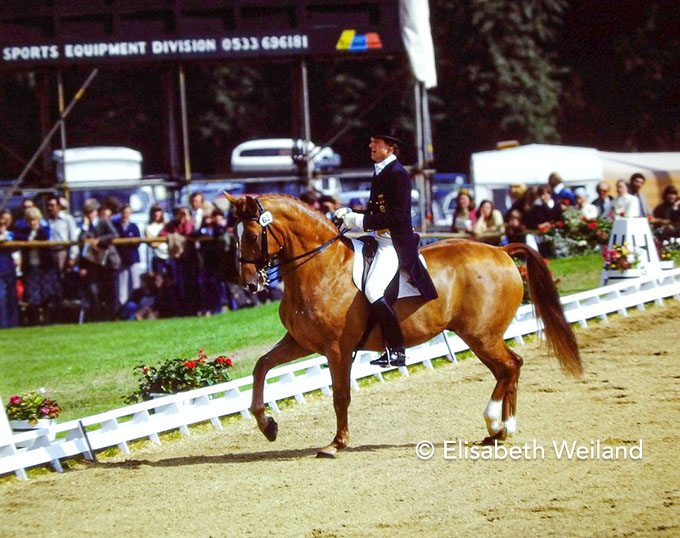
Slibowitz were in top form and seriously challenged Christine
Stückelberger and Granat. In the end they had to be content with
individual silver, even though some saw in them the
winner on that day.
The Swiss who had taken the silver at the Olympics two years earlier were still missing a strong third rider, but seemed superior to the Soviet team which had to rebuilt its team since the retirement of their mainstays Pepel, Ikhor, and Tarif xx. The USA travelled with exactly the same team to England that had won the team bronze medal in Montreal, with Denmark having beaten them a week earlier. So the battle for the bronze medal seemed fairly open, while gold and silver were pretty much determined.
The day before the team competition, like at the previous World Championships, an Intermediate II class was offered to „warm up“ the championships horses, although some of the top ones like Granat, Woyzeck or Slibowitz were not allowed to take part due to their high number of wins or placings in the Grand Prix. Swiss Ulrich Lehmann from the cavalry school in Berne took the chance on his 13-year-old Swedish gelding Widin and won, indicating his great form and significant improvement since the Olympic Games.
Grand Prix / Team competition
On the day of the Grand Prix 33 riders of 11 nations, 7 teams of 3 riders each, started in the Grand Prix in a sold out arena, quite a feat for a country in which back then a comparatively little number of horse people knew exactly what dressage was all about, let alone the wider public.
Unfortunately Sweden had to withdraw its team of three ladies when Anne-Lie Thuressons’ Juanillo (SWB by Juan) couldn’t start, so Ulla Hakanson and Eva-Karin Oscarsson had to ride as individuals.
Eleven of the 33 horses had already been at the Olympic Games in Montreal 1976, with the Hanoverian Monaco was the oldest horse at age 17 and three horses were just 8 years of age: Coq d’Or (SWB by Gaspari), Mon Cherie (Hanoverian by More Magic xx), and Limandus (KWPN by Markies).
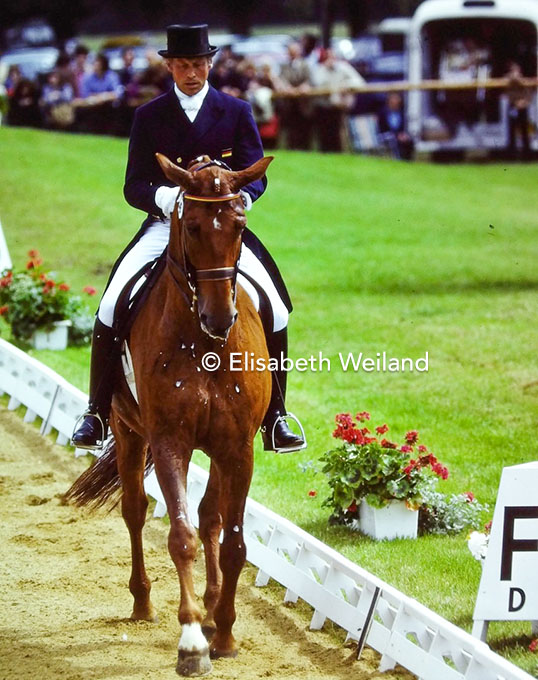
title were shattered on the morning of the individual
competition. Woyzeck slipped in the stables and
struggled to remain sound throughout his ride.
Harry Boldt’s 12-year-old big framed gelding Woyzeck (by Wunsch II) had come very close to Granat in the Grand Prix of Montreal in 1976. In Goodwood he showed a safe and faultless programme, but lacked a bit of freshness, according to his rider. Granat who then was unbeaten since Aachen 1974 showed his evil side, bucking before entering the arena, but then he behaved and performed to his usual standard, even though small mistakes in the canter tour influenced the final result, which was still almost 60 points better than Woyzeck’s.
Only British judge Joan Hall, herself a three times dressage Olympian in the 1960s, put Woyzeck over Granat while Swedish judge Gustaf Nyblaeus placed Boldt’s horse only 4th. Nyblaeus preferred Germany’s second team horse Slibowitz who was ridden courageously by his young rider Uwe Schulten-Baumer junior and both well contributed to Germany’s gold medal.
Ulrich Lehmann and Widin strengthend Switzerland’s silver medal position with a good ride that brought them a 5th individual place in the Grand Prix. Germany’s third rider, Gabi Grillo, scored ten points higher on her charming black Trakehner gelding Ultimo who was also 4th in Montreal in the individual competition.
Finally Germany took the gold 274 points ahead of Switzerland. What sounds a huge margin in our days, was significantly less leeway than the Germans had at the Olympics in 1976 where it had been an incredible 471 points.
The run for the team bronze medal became a rather tight one between the Soviet Union and the USA, whereas Denmark lost their chance when their best pair, Ulla Petersen and the English thoroughbred Chigwell xx, were unable to deliver the high scores of the past two years. The drop dead gorgeous Said, a crossbred between Arab and Russian Trakehner, was the highest scorer for his team. Ridden by young Irina Karacheva, the chestnut with the long mane came 6th, her team mate Viktor Ugrimov with the brown Shkval 11th. Former double World champion Dr. Elena Petushkova scored lower on the just 9-year-old stallion Abakan. The leggy Akal-Teke had the same black colour like his sire, the legendary Absent who was Olympic champion in 1960 and collected 3 more Olympic medals until 1968.
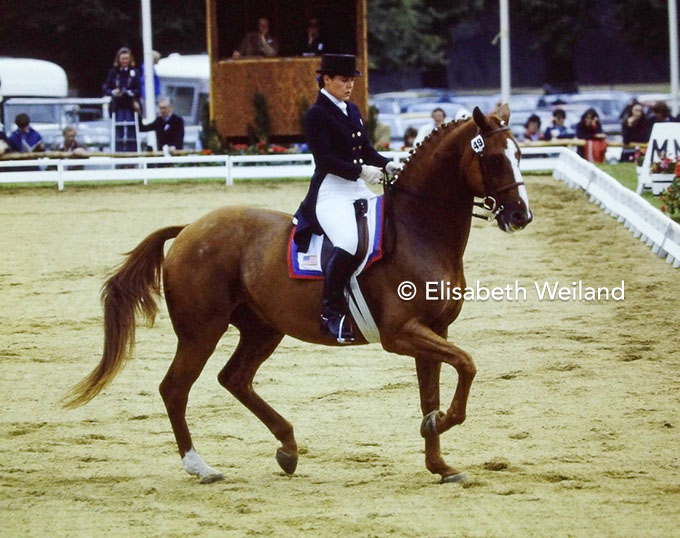
medalist Keen xx also found many admirers in Goodwood,
amongst them Willi Schultheis. They came 7th in the Special.
Of the 7 teams the host nation finished in 6th position. Two of their three riders scored lower than Britain’s individual starter, Trish Gardiner and Manifesto. Their anchor and individual hope, Jennie Loriston-Clarke, recovered from a mediocre Intermediate II, in which the small, but mighty Dutch bred stallion with the appropriate name Dutch Courage was rather too fresh and made too many mistakes. After Jennie had taken him twice around the race-course of Goodwood and warmed him up more than two hours (!), the dark brown foundation stallion of her now so renowned breeding program placed 8th in the Grand Prix and qualified for the Grand Prix Special.
German individual rider Uwe Sauer and the highly refined Trakehner Hirtentraum and Cynthia Neal (now known as Cindy Ishoy) from Canada and the Hanoverian Martyr were the only two individual riders to qualify for the ride-off on the last day.
Grand Prix Special / Individual Competition
On Sunday morning early birds among the spectators could observe Christine Stückelberger’s trainer Georg Wahl leading Granat around the property, like he did all the days before. Protected by a cotton wool sheet against the morning mist and in a halter, the huge Holsteiner walked in tune with his master and took a nip of grass here and there.
His turn was still a few hours away as was his biggest rival Woyzeck’s. The chestnut with the wonderful temperament took a morning nap in his stable where fresh shavings had been sprinkled. When his rider came into the stables, Woyzeck intended to jump to his feet, but slipped with his hindquarters and hurt himself. After lots of considerations and hours passing by the horse seemed okay enough again to compete.
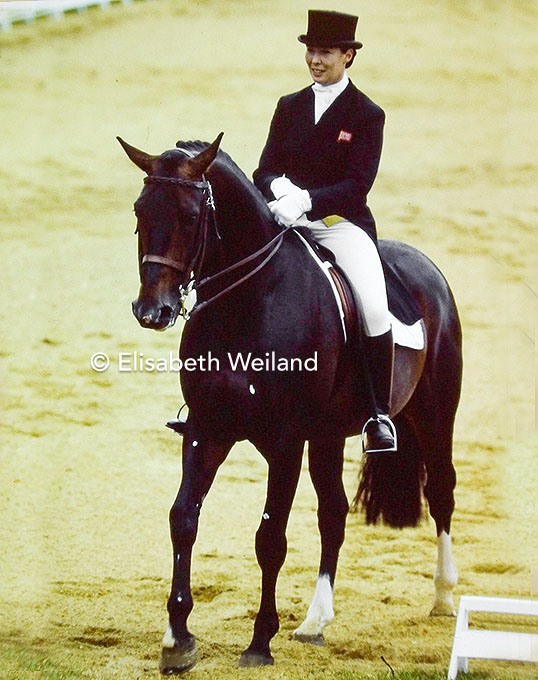
Ulrich Lehmann came very close with his big passaging Widin, but had to be content with a result just 3 points behind the Brit. Perhaps it was the kick after the spurs in the last piaffe that cost the Berne based rider the individual medal? Who knows?!
It wasn’t the day of Germany's sympathetic Gabriela Grillo and her 15-year-old Ultimo who were far from repeating their 4th place from a day earlier. The Trakehner gelding did a few mistakes and finished in 10th place. A strong improvement came from Cynthia Neale and her dark brown Hanoverian gelding Martyr, who didn’t shy away from the difficult task and improved four ranks to 8th place, which at that time was the highest Canadian placing ever. This record Cindy would improve herself a few years later with another Hanoverian, Dynasty).
Hilda Gurney and Keen xx were the best of the two US pairs, finishing in 7th place. Dorothy Morkis was 11th on the grey Hanoverian Monaco.
The third placed pair of the Grand Prix, Uwe Schulten-Baumer had nothing to loose with the strong boned Slibowitz (by Servus) and risked all. The well trained and very submissive horse, who made his debut at Grand Prix at just 7 years of age, gave it his all, only that the quality of his piaffe could not contest with that of Granat or Dutch Courage. He broke into canter once in an extended trot. The judges team of Colonel Sommer from Denmark, Colonel Nyblaeus from Sweden, Joan Hall from Great Britain, Wolfgang Niggli from Switzerland and Donald Thackeray from the USA awarded 1341 points. That result was almost 100 points better than that of fallen favourite Harry Boldt whose reliable Woyzeck, unlike the assumptions, could not completely deny the stable accident of the morning.
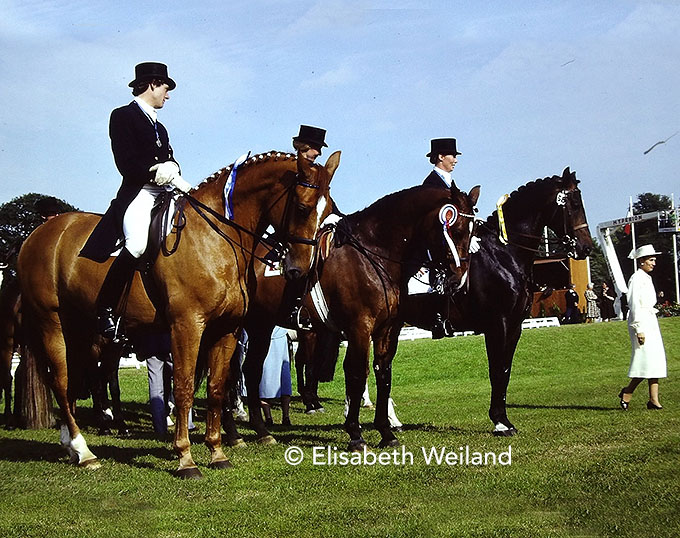
junior, Stuckelberger, Loriston-Clarke
Although not unexpected, the grandioso moment was almost eclipsed by the incredible sensation that Jennie Loriston-Clarke caused by becoming the first dressage rider of her country to win an individual medal. Goodwood 1978 and Dutch Courage’s bronze medal gave British dressage the boost it needed to get where the discipline is today.
Breeding at the 1978 World championships
Nowadays the German, Danish and Dutch studbooks rule the roost in dressage horse breeding. Back in 1978 it was Germany which undoubtedly was the leading country in breeding and producing dressage horses.
Of the 33 horses in the Grand Prix, ten were bred and registered with German breeding associations. Six of them were Hanoverians: team gold medalists Slibowitz (by Servus) and Woyzeck (by Wunsch II x Deputant), Monaco (by Markgraf) and Dahlwitz (by Impuls/Trak x Duellant) on the US team as well as Velten Sohn (by Velten xx) for Denmark. Austrian Sissi Theurer showed the 6th Hanoverian, the dapple grey gelding Mon Cherie (by More Magic xx). Holstein had individual World champion Granat (by Consul x Heintze) and the grey gelding Marquis (by Manometer xx) of Austrian individual Ines von Badewitz. The German team also had the two pure-bred Trakehners of the field: Gabi Grillo’s team gold medalist Ultimo (by Heros x Gabriel) and Hirtentraum (by Traumgeist xx x Komet) who placed 9th as individual rider.
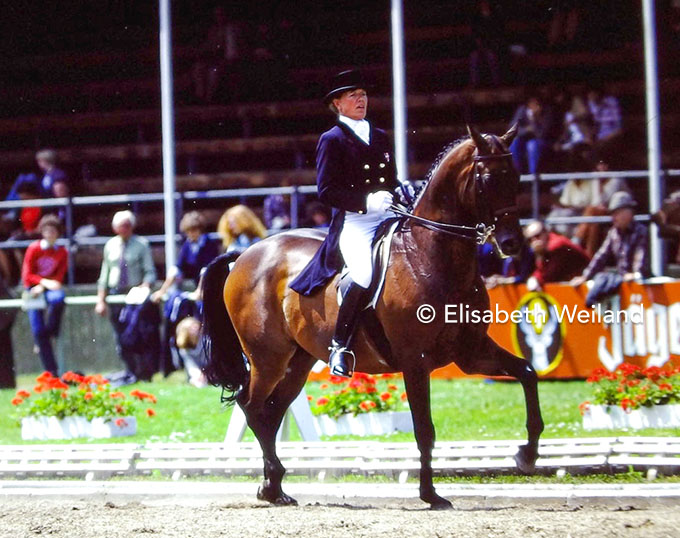
elegant English thoroughbred Chigwell xx. With the high strung
gelding the Horsholm based rider was on Danish teams
from 1972 on.
Sweden was still on the rise and had five horses in the Grand Prix: the former jumping horse Elymus (by Utrillo x Drabant) of Ulla Hakansson and Eva Karin Oscarsson’s Lansad (by Crown Point xx x Herzog) for Sweden, the colored chestnut Coq d’Or (by Gaspari) on the Danish team, the experienced Junker (by Juaw) for Britain and the team silver medalist Widin (by Obelisk x Idealist) of Ulrich Lehmann.
The Netherlands slowly creeped into dressage with the first horses and won the first medal through Dutch Courage who was by the jumping sire Millerole xx. This might explain why the stallion later was also well known as an eventing sire. He took a serious influence on dressage horse breeding in Great Britain and sired his rider’s 1988 Olympic horse Dutch Gold (out of a thoroughbred mare).
Breeding stallions in international dressage sport still remained an exception at that time and not many stallions competed compared to nowadays where the sport is an indispensable way to promote a sire. The chestnut gelding Ivar, ridden by Dutch O-judge Francis Verbeek van Roy, was one of the first KWPN horses by the highly influential Trakehner sire Doruto whose offspring would be found on different championships team well into the 1990s.
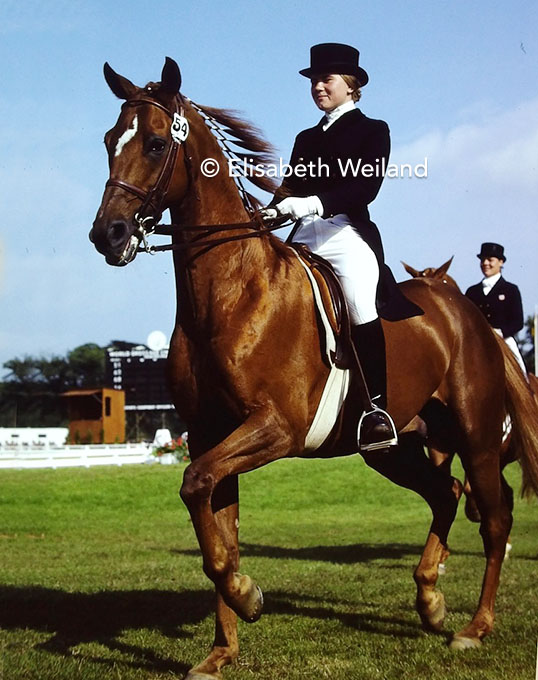
The Soviet Union had a contingent of home bred horses, but not necessarily of a similar phenotype. The petite and highly refined chestnut Said (by Samokhod) was an intended crossbred between Arab and Trakehner, while the bigger framed black Abakan was a pure-bred Akal-Teke by Absent, the Soviet Union’s first Olympic champion of 1960.
Denmark, Hungary and France only had one breeding product each: Lazuly of Tove Jorck-Jorckston for Denmark, the team silver medalist Scorpio of Claire Koch, and the Anglo Arab Le Baby of Dutch Frederica Benedictus-Liftinck.
Ten years later at the Olympic Games in Seoul the breeding part would look a bit different which shows how fast specialized breeding evolved during that time.
Text © by Silke Rottermann for Eurodressage
Photos © Elisabeth Weiland - No reproduction without written permission/payment
Scores: 1978 World Championships
Related Links - World Championships Series
1974 World Championships in Copenhagen: The Most Picturesque World Championships
World Championships Copenhagen 1974 Through The Eyes of Ruth Klimke
1970 World Championships in Aachen: Soviet Union Defeats Germany
World Championships Aachen 1970 Through The Eyes Of Ulla Hakanson
Finally Official - The First Dressage World Championships 1966
World Championships Berne 1966 Through The Eyes Of…
References for this article
- Interview with Christine Stückelberger, Zürich, 4th June 2022.
- Harry Boldt, Das Dressurpferd, Edition Haberbeck, Lage-Lippe 1978, p. 253-345.
- Jane Kidd, Goodwood Dressage Champions, Kenilworth Press, Buckingham 1994.